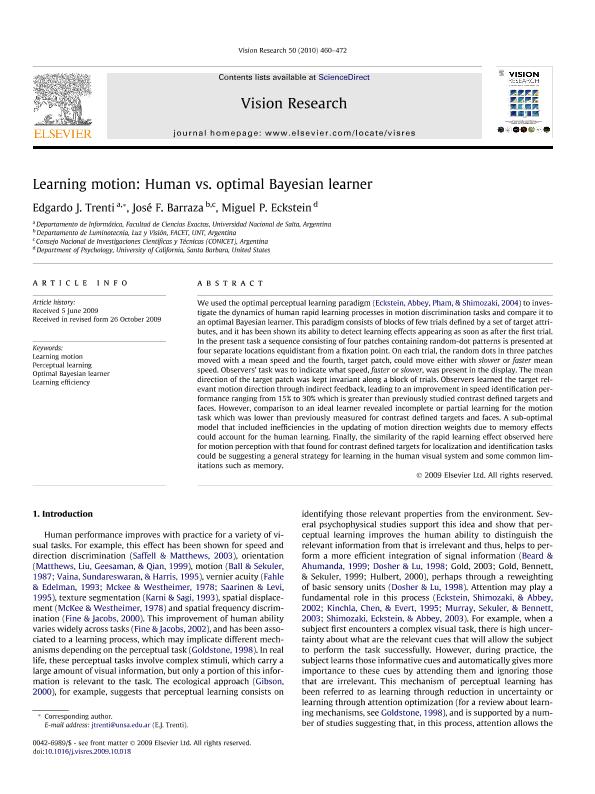Mostrar el registro sencillo del ítem
dc.contributor.author
Trenti, Edgardo Javier

dc.contributor.author
Barraza, Jose Fernando

dc.contributor.author
Eckstein, Miguel P.
dc.date.available
2020-02-10T19:37:19Z
dc.date.issued
2010-02
dc.identifier.citation
Trenti, Edgardo Javier; Barraza, Jose Fernando; Eckstein, Miguel P.; Learning motion: Human vs. optimal Bayesian learner; Pergamon-Elsevier Science Ltd; Vision Research; 50; 4; 2-2010; 460-472
dc.identifier.issn
0042-6989
dc.identifier.uri
http://hdl.handle.net/11336/97098
dc.description.abstract
We used the optimal perceptual learning paradigm (Eckstein, Abbey, Pham, & Shimozaki, 2004) to investigate the dynamics of human rapid learning processes in motion discrimination tasks and compare it to an optimal Bayesian learner. This paradigm consists of blocks of few trials defined by a set of target attributes, and it has been shown its ability to detect learning effects appearing as soon as after the first trial. In the present task a sequence consisting of four patches containing random-dot patterns is presented at four separate locations equidistant from a fixation point. On each trial, the random dots in three patches moved with a mean speed and the fourth, target patch, could move either with slower or faster mean speed. Observers' task was to indicate what speed, faster or slower, was present in the display. The mean direction of the target patch was kept invariant along a block of trials. Observers learned the target relevant motion direction through indirect feedback, leading to an improvement in speed identification performance ranging from 15% to 30% which is greater than previously studied contrast defined targets and faces. However, comparison to an ideal learner revealed incomplete or partial learning for the motion task which was lower than previously measured for contrast defined targets and faces. A sub-optimal model that included inefficiencies in the updating of motion direction weights due to memory effects could account for the human learning. Finally, the similarity of the rapid learning effect observed here for motion perception with that found for contrast defined targets for localization and identification tasks could be suggesting a general strategy for learning in the human visual system and some common limitations such as memory.
dc.format
application/pdf
dc.language.iso
eng
dc.publisher
Pergamon-Elsevier Science Ltd

dc.rights
info:eu-repo/semantics/openAccess
dc.rights.uri
https://creativecommons.org/licenses/by-nc-sa/2.5/ar/
dc.subject
LEARNING EFFICIENCY
dc.subject
LEARNING MOTION
dc.subject
OPTIMAL BAYESIAN LEARNER
dc.subject
PERCEPTUAL LEARNING
dc.subject.classification
Otras Ingenierías y Tecnologías

dc.subject.classification
Otras Ingenierías y Tecnologías

dc.subject.classification
INGENIERÍAS Y TECNOLOGÍAS

dc.title
Learning motion: Human vs. optimal Bayesian learner
dc.type
info:eu-repo/semantics/article
dc.type
info:ar-repo/semantics/artículo
dc.type
info:eu-repo/semantics/publishedVersion
dc.date.updated
2019-06-04T15:56:21Z
dc.journal.volume
50
dc.journal.number
4
dc.journal.pagination
460-472
dc.journal.pais
Estados Unidos

dc.journal.ciudad
Nueva York
dc.description.fil
Fil: Trenti, Edgardo Javier. Universidad Nacional de Salta. Facultad de Ciencias Exactas; Argentina
dc.description.fil
Fil: Barraza, Jose Fernando. Consejo Nacional de Investigaciones Científicas y Técnicas. Centro Científico Tecnológico Conicet - Tucumán. Instituto de Investigación en Luz, Ambiente y Visión. Universidad Nacional de Tucumán. Facultad de Ciencias Exactas y Tecnología. Instituto de Investigación en Luz, Ambiente y Visión; Argentina
dc.description.fil
Fil: Eckstein, Miguel P.. University of California; Estados Unidos
dc.journal.title
Vision Research

dc.relation.alternativeid
info:eu-repo/semantics/altIdentifier/url/https://www.sciencedirect.com/science/article/pii/S0042698909004982
dc.relation.alternativeid
info:eu-repo/semantics/altIdentifier/doi/https://doi.org/10.1016/j.visres.2009.10.018
Archivos asociados
